Optometrists are well versed in recognizing functional concerns and managing ocular disease treatment, yet many do not consider the various dermatological options and surgical procedures available for aesthetic enhancement of the eyes—and many patients, while curious, many not know how to ask.
When discussing aesthetics around the eyes, says Wendy Lee, MD, an oculoplastics surgeon at Bascom Palmer Eye Institute in Miami, it’s important to first remember the anatomy of the periocular area and why it is vulnerable to aging. Periorbital skin is the thinnest on the body and contains lower numbers of sebaceous glands than other areas. These glands produce sebum to lubricate and waterproof the skin; with fewer glands, periorbital skin tends to dry out and wrinkle faster. A lack of subcutaneous tissues beneath the thin eyelid skin means the skin tightly adheres to the underlying muscles, which are constantly contracting and transmitting movement to the delicate tissue.
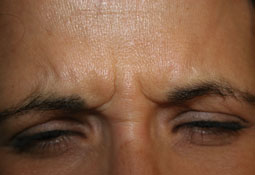 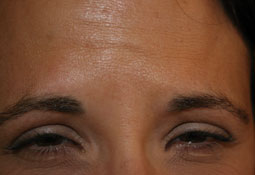 | |
| Before (left) and after (right) an injection of botulinum toxin between the eyebrows. Photos: Wendy W. Lee, MD. |
As we age, our skin becomes thinner and loses its elasticity as a result of slower production of the proteins collagen and elastin, which impacts the skin’s ability to repair itself and hold its shape.1 Age also affects bone, tendon and muscle mass, which can alter the shape of the periorbital area.
The reason we notice signs of aging around the eyes faster, says Dr. Lee, is because the eyes are the aesthetic center of the face. It is typically the area we focus on when we’re talking and listening to other people, so any irregularities or blemishes are noticed more quickly than if they were present on other parts of the body. For this reason, many patients are concerned with making sure their eyes and surrounding skin look as symmetrical, youthful and healthy as possible.
Hydrate and Protect
The most basic education optometrists can provide to their patients is on preventative care, namely: hydrate and protect. When it comes to hydration, “anyone who has dryness in the eyelids will notice more accentuation of fine lines and creases,” says Hilary Johnson, MD, clinical assistant professor of dermatology at the University of Iowa Carver College of Medicine. Most facial creams contain a hydrating agent, but it’s important to select one designed specifically for eyelid use to avoid complications.
Adequate sun protection is a must as well. “It’s hard for us to think of the eyelids as one of those places to include sunblock, but we see a lot of skin cancer in the eyelid in older folks so it’s not a bad idea. From a cosmetic point of view, a lot of our signs of aging, including the skin around the eyelid, is related to exposure from ultraviolet light from the sun,” Dr. Johnson says. Patients should remember to apply a stick sunblock around the eyes, which she says is easy to apply and won’t drip in the eyes.
| Permanent Makeup By Elyse L. Chaglasian, OD Permanent tattooing of the eyelids, eyelashes and eyebrows has become a popular practice for those seeking a more convenient, longer-lasting and less irritating alternative to daily makeup application and removal. Known as blepharopigmentation, the procedure was first described by Giora Angres, MD, in 1984 and involves the application of iron oxide pigment along the lash line using a rotary needle.2 While blepharopigmentation yields desirable results, there are some concerns surrounding both the materials used and the skill of the operators. The FDA does not regulate the tattoo industry, including the inks or dyes used; these have been known to elicit infection, allergic reactions, granulomas and dermatitis in various individuals.3-5 Technician training and licensing is also unregulated, increasing the risk of poorly trained individuals making a mistake. Results from an FDA phone survey with 92 patients who reported adverse events after permanent makeup application indicated that tenderness (95%), swelling (91%), itching (88%) and bumps (83%) were the most common reactions. Sixty-three (68%) patients reported that their reactions had not completely resolved at the time of the survey; duration of the symptoms ranged from five and a half months to over three years.6 |
Kimberly Cockerham, MD, an ophthalmologist in Stockton, Calif., agrees with Dr. Johnson that sun protection is key, and points out that powdered micronized zinc oxide and titanium oxide are other good ways to protect the eyelids, as they defend against ultraviolet (UV) light better than chemical blocks. While not a makeup, Dr. Cockerham says, some companies make the powders available in shades other than neutral.
While certainly not an easy fix, applying a clear or tinted UV-protective film to car windows could ensure patients are protected when they are the most vulnerable. “Most people get the vast majority of their sun exposure driving,” Dr. Cockerham says. “Adding UV protection to your car window will help prevent premature aging, and it’s going to help the eye-related issues that are secondary to UV exposure.” Note, window tinting is regulated in most states.
Topicals
Patients generally present with one of three main complaints, Dr. Lee says: dark circles, wrinkles or puffiness. Topical eye creams can be a great treatment option, but optometrists have to be careful to suggest the right ones, since “with topical eye creams, it’s not one size fits all,” says Dr. Lee. “Antioxidants for instance, like vitamin C and green tea, help to fight free radicals, so, not only damage from the sun but also environmental factors [like pollution].” Different products target different problems, so it is important to listen to your patient about what bothers them the most, then try to match that with physical findings.
Dr. Lee recommends targeting wrinkles using creams containing retinols, which help to stimulate collagen. Dark circles, on the other hand, are much tougher to treat because they are due to several factors. Dark circles are partially the result of oxygenated blood pooling in the veins underneath the thin under-eye skin, which can be exacerbated by a variety of factors, including allergies, fatigue and age. The fat-soluble vitamin K, which plays an essential role in blood clotting, has been shown to reduce the severity of bruising following cosmetic laser surgery and may have a similarly minimizing effect on blood that pools in the veins underneath the eye.7 Topical retinol may also help reduce the appearance of dark circles by thickening the lower layer of the epidermis and dermis, in turn increasing blood flow and collagen production within the skin.8
Puffiness around the eyes is also a concern patients can address with topical creams, notes Dr. Lee, although she warns that they won’t work for all patients. “My take on puffiness is to be realistic. What is the puffiness due to? Most of the time, when my patients come in complaining of puffiness, it’s really fat prolapse, which is a surgical issue. Topicals are not going to take that puffiness away.”
If the swelling is edema from lifestyle choices like smoking or sleep deprivation, Dr. Lee recommends the use of topical arnica, a homeopathic remedy sometimes used to treat muscle aches and post-surgical pain and swelling. However, take care to avoid getting it directly in the eye, and keep in mind its limitations on decreasing actual edema around the eyes.
Injectables
Botulinum toxin is a neurotoxin produced by the bacterium Clostridium botulinum that, when injected, temporarily prevents muscle contraction.9 First demonstrated to treat strabismus in 1981, it has since been approved by the FDA under the brand names Botox (Allergan), Dysport (Galderma) and Xeomin (Merz Pharma) for the treatment of various spastic muscle dystonias and similar medical conditions.9
Cosmetically, botulinum toxin is used to shape the periocular region, explains Dr. Lee. “Not only can dynamic wrinkles be softened in the glabella region, but you can also create a nice medial brow lift at rest. As far as lateral canthal lines go, you can rejuvenate and improve the crow’s feet area,” she says. Botulinum toxin can also be injected underneath the eyelids into the pretarsal orbicularis to decrease the roll patients sometimes develop. It can also work to create a subtle widening of the palpebral fissure, making the eyes appear more open.
However, caution should be taken when making these injections in patients with preexisting dry eye, Dr. Lee warns, as they can exacerbate the condition by weakening the orbicularis. Additionally, while botulinum toxin can be used off-label in the lateral brow area and forehead, “you have to be careful when injecting that area because you can actually drop the brows and crowd the periorbital area,” Dr. Lee says. Optometrists should be sure to educate themselves and their patients regarding the anatomy in this area, as well as all potential consequences.
Dermal fillers are another injectable better suited for reducing static wrinkles, or wrinkles that are present when the face is at rest. If injecting around the eyes, Dr. Lee recommends use of hyaluronic acid, since it is reversible with hyaluronidase. “The tear trough is probably the most popular area around the eyes to inject, as it helps fill in the volume deficits and contour changes between the lid-cheek junction,” she says. At the same time, however, “the tear trough is very unforgiving because of the thinness of the skin and if you inject too much, you’re going to see lumps and bumps.”
Lasers
Laser skin resurfacing is a non-surgical technique capable of reducing facial wrinkles, scars and blemishes by stimulating growth of collagen fibers.10
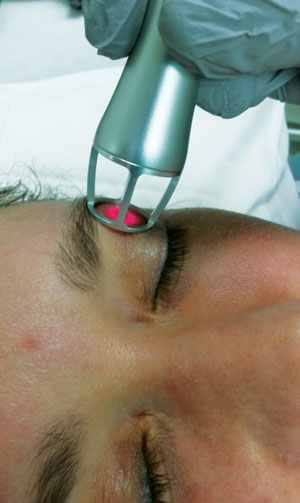 | |
| The Co2 laser in action on an eyelid. Photo: Hillary D. Johnson, MD. |
“It’s one of the few devices I think that truly smooths and tightens the skin. It’s a nice thing to do along with eyelid surgery,” Dr. Johnson says. “It helps reduce signs of aging, reduces brown spots and wrinkles and builds for tighter skin.” Recent laser resurfacing technology uses a fractional form, treating microscopic columns of skin. In general, fractional laser-resurfacing treatments fall under two categories: ablative and non-ablative. Fractional ablative lasers are more invasive, require more recovery time and are more effective. Non-ablative fractional resurfacing lasers and lasers that use radio frequency technology require less downtime but are also less effective.11,12 “Carbon dioxide fractional laser resurfacing is my all-time favorite for safe resurfacing of the eyelids with noticeable improvement after one treatment, but you would want to make sure that the person operating the laser has a lot of experience,” Dr. Johnson says.
Regardless of the type of laser or light used, Dr. Lee cautions that the patient and everyone in the operating room should wear eye protection during the procedure. “Most of [the lasers] are very absorbent in water, but there are some that will absorb into pigment and hemoglobin as well, which puts your retina and iris at risk,” she says.
Dr. Johnson recommends the patient be given certain medications in advance to handle the discomfort associated with healing time and to protect against reactivation of cold sores or herpes simplex virus. Patients with rosacea, including ocular rosacea, do not see a large difference in how the skin heals. However, rosacea patients “tend to have more sensitive skin in general. We use a different laser on the rest of the face, the pulsed dye laser, to reduce the appearance of red blood vessels, and folks with rosacea tend to be more sensitive in terms of having more skin allergies,” she says.
For patients with hyperpigmentation, the effects of laser resurfacing depend on the cause of the skin coloring. Brown spots caused by irritation or allergic reactions often fade on their own, and skin conditions like melasma can be treated using sunblock and prescription bleaching cream. “That tends to have a better track record than certain lasers that target pigment,” Dr. Johnson says. “Then there are folks who have brown around the eyelids from mole cells (nevus of ota). We can use a laser for that, which targets the pigment in the skin cells.”
Dr. Cockerham notes laser resurfacing should be avoided in patients who have a higher amount of melanin in their skin than Caucasian patients. “The laser works by causing thermal damage to the skin. Thermal damage to melanocytes can result in hyperpigmentation and scarring,” she says, adding that microneedling is often a good alternative for these patients. Optometrists in states that allow injections into skin could potentially provide this service.
Surgery
The most common surgical enhancements for periorbital rejuvenation are blepharoplasties of both the upper and lower lids, which are particularly useful for patients with fat prolapse and excess skin, Dr. Lee says. During the procedure, incisions are typically made along the natural upper eyelid crease or through the conjunctiva or just below the eyelashes on the lower eyelid. Fat, muscle and excess skin are then removed and the lids are tightened as needed.
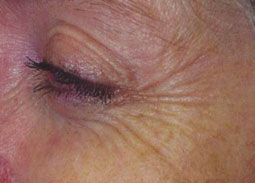 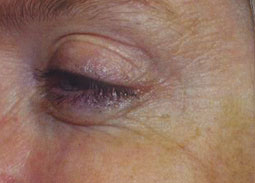 | |
| Before (left) and after (right) an injection of botulinum toxin to soften crow’s feet. Photos: Wendy W. Lee, MD. |
Lower eyelid blepharoplasty is usually more cosmetic in nature to reduce under-eye puffiness eye bags or improve wrinkles, while upper eyelid blepharoplasty is more commonly done to address functionality in older patients with vision impairment caused by ptosis. A third type of blepharoplasty, known as double eyelid surgery, is popular among Asians and Asian Americans; it involves the creation of a crease in the upper eyelid.13
Optometrists can work together with ophthalmologists to enhance pre- and postoperative care, says Erin Shriver, MD, assistant professor in the Department of Ophthalmology and Visual Sciences for University of Iowa Health Care. For example, patients with blepharitis should be placed on a regimen of warm compresses to improve lid hygiene before surgery, and then for several weeks after, she says.
Additionally, an optometrist should be consulted if the patient wears contact lenses, especially if the lenses are being used for purposes other than refractive correction, such as to preserve the ocular surface. Typically, says Dr. Shriver, contact lenses should remain out for at least a week following surgery to prevent aggravation of dryness that can result following the procedure.
Optometrists are uniquely qualified to manage ocular surface conditions such as ocular rosacea, blepharitis and dry eye before and after eyelid and other cosmetic periocular procedures; thus, they can play a pivotal role in the education and comanagement of patients interested in ocular aesthetics—be it topicals, injectables, laser resurfacing or surgery.
1. The International Dermal Institute. Structural Changes Associated with Aging Skin. Available at: www.dermalinstitute.com/us/library/11_article_Structural_Changes_Associated_with_Aging_Skin.html. Accessed May 5, 2015.2. Angres GG. Eye-liner implants: A new cosmetic procedure. Plast Reconstr Surg. 1984 May:73(5):833-6.
3. De Cuyper C. Permanent makeup: indications and complications. Clin Dermatol. 2008 Jan-Feb;26(1):30-4.
4. Vagefi MR, Dragan LD, Hughes SM, et al. Adverse reactions to permanent eyeliner tattoo. Ophthal Plast Reconstr Surg. 2006 Jan-Feb;22(1):48-51.
5. Rubianes EL, Sanchez JL. Granulomatous dermatitis to iron oxide after permanent pigmentation of the eyebrows. J Dermatol Surg Oncol. 1993 Jan;19(1):14-6.
6. Straetemans M, Katz LM, Belson M. Adverse reactions after permanent-makeup procedures. N Engl J Med. 2007 Jun;356(26):2753.
7. Shah NS, Lazarus MC, Bugdodel R, et al. The effects of topical vitamin K on bruising after laser treatment. J Am Acad Dermatol. 2002 Aug:47(2):241-4.
8. Mukherjee S, Date A, Patravale V, et al. Retinoids in the treatment of skin aging: an overview of clinical efficacy and safety. Clin Interv Aging. 2006 Dec;1(4):327-38.
9. Nigam PK, Nigam A. Botulinum toxin. Indian J Dermatol. 2010 Jan-Mar;55(1):8-14.
10. American Society of Plastic Surgeons. What is laser skin resurfacing? Available at: www.plasticsurgery.org/cosmetic-procedures/laser-skin-resurfacing.html. Accessed May 5, 2015.
11. Alexiades-Armenakas MR, Dover JS, Arndt KA. The spectrum of laser skin resurfacing: nonablative, fractional and ablative laser resurfacing. J Am Acad Dermatol. 2008 May:58(5):719-37.
12. Preissig J, Hamilton K, Markus R. Current laser resurfacing technologies: A review that delves beneath the surface. Semin Plast Surg. 2012 Aug;26(3):109-16.
13. Nguyen MQ, Hsu PW, Dinh TA. Asian blepharoplasty. Semin Plast Surg. 2009 Aug;(3):185-97.

